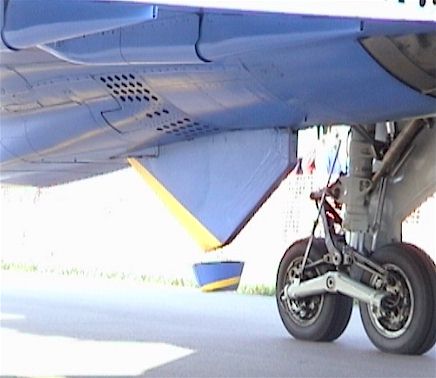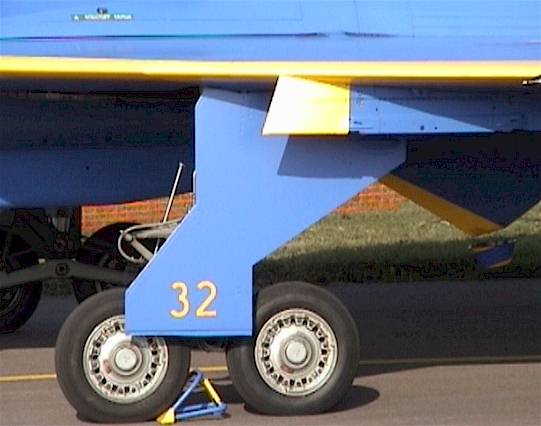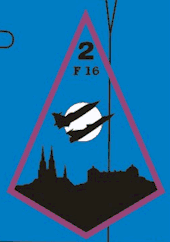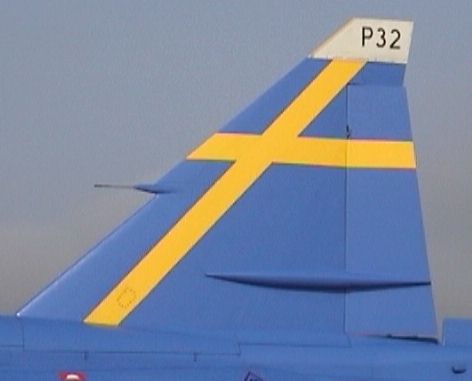by Stefan Eriksson
drawings by Anders Nowotny
About Blue Peter
In the recent years the Swedish Air Force has been busy painting aircrafts to celebrate different kinds of anniversaries or commemorate end of operations. As part of this trend, we have already seen many colourful J 35 Drakens. As the Viggen is rapidly nearing the end of its operational life, colorful J 37s are also likely to appear. One good example is the blue-painted JA 37 which was the star of static display at Air Show 2001 in Uppsala – a large and memorable event marking the 75th anniversary of the Swedsih Air Force. The aircraft, called Blå Petter (Blue Peter) became the object of vivid interest of many SwAF fans. This article describes the story and details of this particular aircraft and its paint scheme.
Like many other countries, during 1990s Sweden has entered a arms-reduction program aimed at adopting the size of the country’s military force to the new requirements after the Cold War’s end. The Swedish Air Force, traditionally playing a maojor part in the defensive capability of Sweden, is also being affected. The program includes both reducing the number of units as well as convertion to the next generation of tactics and equipment.
F 16, also called the Uppland Wing, is a unit rich in tradition. It is located in the middle of Sweden, with the home base near the historic town of Uppsala. This unit has been the host of 2001 national Air Show.
When the 2nd and 3rd Squadrons at Uppland Wing F 16 closed down in year 2000, the technical personnel at 2nd Squadron decided to paint a JA 37 overall blue to celebrate this event. The choice of the color was natural – blue has been the color of 2nd Squadron.
The two squadrons were later reformed into a single squadron which is currently operating JA 37 Viggen out of F 16 base.

Top view of Blå Petter showing the wing insignia as well as the extent of yellow leading edges on the flying surfaces. Drawing (c) 2001 Anders Nowotny. Used by Permission.
The Aircraft
The aircraft which was painted blue has serial number 37432. It has been the 132 production JA 37 built by Saab and was delivered to F 16 wing in 1990. Because the 37432 had only a few flying hours left before an decision of scrapping, she was choosen to be repainted as a commemorative aircraft.
The paint job itself was carried out in the summer of 2000. The colors that were used came from an civilian paint manufacturer, and the blue colour is of water-based variety. That means that the aircraft can only fly in good weather. Operation in harsh weather conditions could wash the finish away. It also means that 37432 cannot be stored on permanent outdoor display. Happily, it is to be saved from scrapping. A small aircraft museum at Visby airport is has agreed to take her under their roof. There she will be on permanent public display indoors.
Modelling Blå Petter
Currently the best JA 37 kit in 1/72 scale is the one from Heller. Heller has updated its old AJ 37 kit with missiles and an gun pack to represent a JA 37. When building the kit, remember that Blå Petter does not have the centerline drop tank mounted.
In the 1/48 scale , the only game in town is ESCI:s hard-to-find JA 37 Viggen kit.
At the moment of writing (October 2001 – Ed.), a decal sheet for Blå Petter is avalible from Anders Nowotny in Sweden. For those interested, Anders can be contacted through nowotny.anders@telia.com. All nessescary information required to finish a correct blue Viggen is on that decal sheet and the instructions that go with it. Even an original blue and yellow paint chip is enclosed. The sheet is avalible in both 1/72 and 1/48 scales, with decal sheet number 720118 and 480118 respectively.
Blå Petter in close-up

Here is how the project started, JA 37 ser. no 37432 in the paint depot of F 16. Modellers will immediately recognize the process – the aircraft in the paint rig wheels up, grey primer applied first, then the lighter yellow color, canopy masked off (no it is not Tamiya masking tape)…
A notable detail is the standard color Swedish national roundel which didn’t make it to the final design. Note that the blue color of Blå Petter is very different from that used in the insignia. Photo: Stefan Eriksson

As can be seen, the blue finish was applied in rather low-tech way with a roller. Photo: Stefan Eriksson

Another angle shows the symbol of the Blue Squadron with inscription PETTER BLÅ. The same symbol is repeated on upper port and lower starboard wing. Photo: Stefan Eriksson

Mid-fuselage section. Note that this aircraft does not carry the centerline fuel tank.
This and subsequent pictures show the aircraft as displayed at Uppsala Air Show in August 2001, with the paint finish being about 1 year old but showing only slight signs of weathering. Photo: Stefan Eriksson

Close-up of the cockpit section reveals the name Blå Petter repeated under the cockpit as well as trhe style of Three Crowns insignia. Photo: Stefan Eriksson

Another close-up of the opposite side of the nose shows that the aircraft’s name has not been repeated on the starboard side.
A details of interest to the modellers is the different angle of front undercarriage cover compared to the previous photo. The cover ”drops” as hydraulic pressure decreases on parked aircraft. Photo: Stefan Eriksson

Rear port fuselage features another insignia, this time a shield of 2nd Squadron F 16 showing a Viggen and a Draken over the skyline of Uppsala. This symbol is repeated on upper starboard and lower port wing. Photo: Stefan Eriksson

Parked Viggens ofthen display this detail, an oil collection pot suspended below the underbelly fin. A neat detail is that this one matches the aircraft’s paint scheme! Photo: Stefan Eriksson
This article was originally published in IPMS Stockholm Magazine in October 2001.






